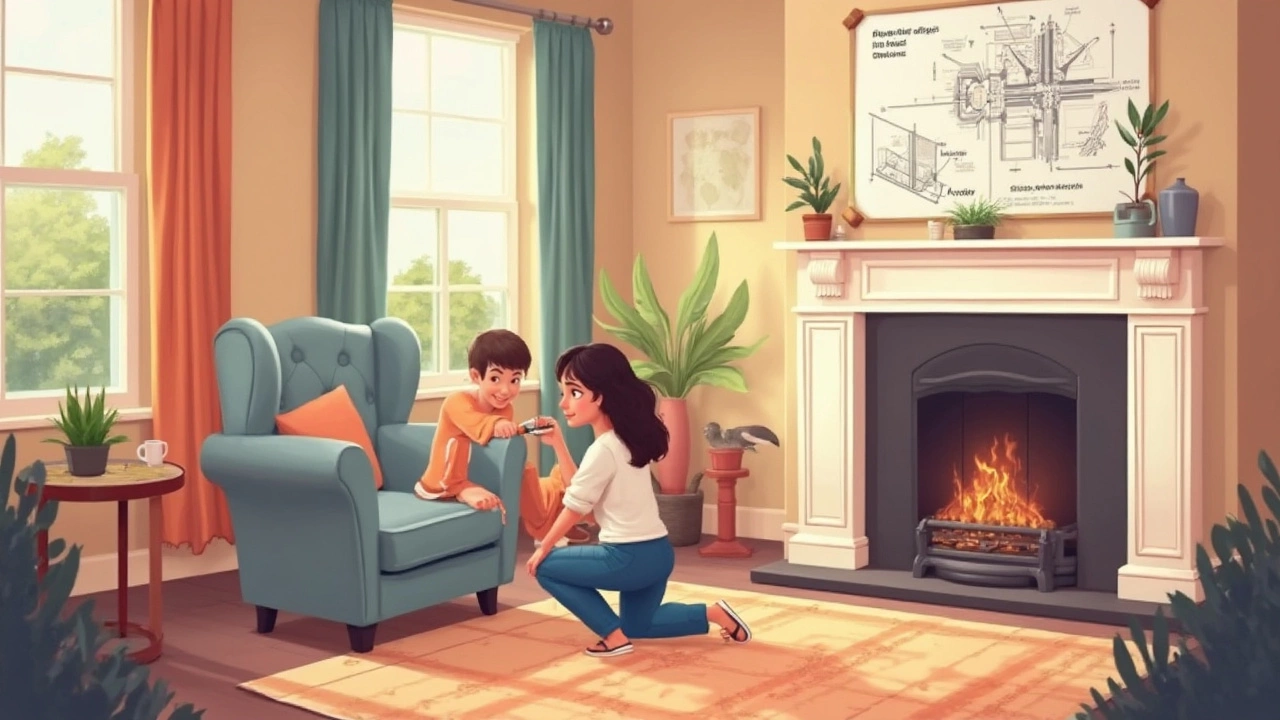Buying a new home is an exciting adventure, but what happens when your dream home has a few unexpected quirks? These quirks, or defects as they're known in the industry, are more common than you might think. Whether it's a leaky roof or a door that doesn't quite close, understanding what qualifies as a construction defect is crucial.
So, what exactly is a defect in a new build? Simply put, it's any element of the home that doesn't meet the standards or expectations set by building codes or the developer's own promises. This could mean anything from structural issues to cosmetic ones.
Knowing the ins and outs of these defects can save you a lot of headaches down the line. Recognizing defects early means fewer surprises and potentially less costly repairs. In the upcoming sections, we'll dig into the most common defects found in new builds, why they happen, and how you, as a homeowner, can spot these issues before they become big problems.
- What Counts as a Defect?
- Common Defects in New Builds
- Causes Behind Construction Defects
- Tips for Identifying Defects
- Handling Defects: What to Do Next?
What Counts as a Defect?
When it comes to new builds, not everything that goes wrong is technically a defect. It helps to know what exactly a defect entails so you can spot them effectively. Generally speaking, a defect is any part of the construction that doesn’t meet specific standards or codes, or fails to perform its intended function.
Structural Defects
Think of these as the big deal issues. Structural defects might include problems like cracks in the foundation or walls, and they can compromise the safety and integrity of the home. These are usually taken very seriously because they can lead to significant issues if left unaddressed.
Cosmetic Defects
Now, not everything is a crisis. Some defects are more about appearance. Maybe your paint is streaky or tiles are uneven. While these don’t typically affect functionality, they can be super frustrating, especially in a brand-new home you've invested in.
Mechanical and Electrical Defects
Mechanical defects cover anything from faulty HVAC systems to plumbing leaks. Electrical defects often involve issues like circuit failures or poorly installed wiring. Both types require prompt attention since they can affect the livability of your home.
Code and Design Non-Compliance
Sometimes builds don't follow local building codes, or they stray from the agreed-upon design. This could include things like missing safety handrails or insufficient insulation. These count as defects too, and they can be sneaky because you might not realize something is off until you really need it.
Performance Issues
Ever had a door that just wouldn’t close right? Or windows that let in a draft? These are performance defects, and they can mess with your comfort in very sneaky ways.
Understanding these categories helps you figure out what you’re dealing with if something seems off in your new home. Remember, it’s not just about spotting the problem, but realizing how it impacts your daily life and property value. Armed with this info, you can decide your next steps and keep your investment secure.
Common Defects in New Builds
So, you've just moved into your brand new home, only to discover that it's not as perfect as you hoped. Unfortunately, construction defects are pretty common in new builds, and they can vary quite a bit.
Structural Issues
The biggies to watch for are structural problems. This includes anything related to the frame of the house, like foundation cracks or misaligned beams. These issues can lead to bigger headaches down the line, so it's crucial to address them early.
Water Leaks
Water is great in pools, but when it’s sneaking in through your roof or basement, it's a problem. Common signs of water leakage include damp spots, mold, and that musty smell nobody wants. Leaks can damage the integrity of a home and lead to costly repairs, so keep an eye out.
Poor Insulation
Then there’s insulation troubles. Sometimes homes are built with inadequate insulation, which can make them less energy-efficient. You might notice drafts, or your energy bills could skyrocket. Proper insulation is key to keeping your home comfortable.
Faulty Electrical Systems
Nobody wants their brand-new lights flickering or outlets sparking. Faulty electrical systems can be a major hazard, so it’s essential that your new build meets electrical codes. Have an inspector double-check the wiring if anything seems off.
Cosmetic Flaws
Finally, there's the cosmetic stuff: crooked tiles, imperfect paint jobs, or uneven floors. While these might not affect the safety of your home, they can be frustrating and costly to fix if not addressed through your builder's warranty.
According to industry reports, about 32% of new build homebuyers encounter construction defects within the first year of moving in.
Keeping an eye out for these common defects when purchasing a new build is important. Ensure any issues are covered under the builder's warranty, and don’t be afraid to bring them up to your developer.

Causes Behind Construction Defects
So, you’ve come across a defect in your brand new build, and now you're scratching your head, wondering how it happened. Well, construction issues stem from a variety of factors, and it’s rarely as simple as pointing a finger. Let’s break down some common causes that might put things into perspective.
Design Flaws
One major culprit behind construction defects is poor design. Architects and engineers who rush or overlook crucial elements can create plans that just don't work in real life. A poorly designed drainage system, for example, could result in a flooded basement, or inadequate structural designs might lead to cracks or worse.
Material Failures
Another common issue is related to the materials used in construction. Using low-quality materials to cut costs can backfire. Imagine constructing a home with cheap drywall only to find it crumbling a year later. It's vital for builders to stick to high-quality materials to avoid future headaches.
Poor Workmanship
Even with perfect plans and high-quality materials, the final construction relies heavily on the workmanship. Hiring skilled workers is crucial, but sometimes builders cut corners by hiring less experienced or untrained laborers. This might lead to uneven floors, faulty wiring, or plumbing issues down the road.
Environmental Factors
Sometimes nature plays a role too. Areas prone to heavy rain, earthquakes, or even termite infestations may see more defects. While builders can’t control these, they can plan for them. Not accounting for local environmental conditions in plans and materials often leads to problems later on.
Understanding Costs
Here's a little data nugget to consider:
| Type of Defect | Percentage Occurrence* |
|---|---|
| Design Flaws | 25% |
| Material Failures | 20% |
| Poor Workmanship | 35% |
| Environmental Factors | 20% |
*Based on industry assessments over recent years.
Understanding these causes can equip you with the knowledge to ask the right questions and demand quality in your build. Whether checking design plans thoroughly or insisting on quality materials, being informed makes all the difference.
Tips for Identifying Defects
Identifying defects in new builds can be like playing detective. You need to know where to look and what clues to watch for. Let's roll up our sleeves and get into the details of spotting issues in your shiny new home.
Start with a Thorough Inspection
The very first step is to get a professional inspection. A trained eye can spot construction mistakes that might get past you. Inspectors look for everything from structural issues to faulty wiring. Make sure they check the attic and basement, places that often hide defects.
Use Your Senses
Your senses are powerful tools. Look for cracks in the walls or ceilings, doors that stick, or windows that won't latch. Feel the temperature in each room; does one space feel drafty or damp? Strange smells might indicate mold or plumbing leaks. Listen for creaks or unusual sounds when walking around; these could be signs of home quality issues.
Uncover Hidden Problems
Don't just skim the surface. Check under sinks for leaks, turn on all the taps to ensure water pressure is consistent, and open every window and door. Test the heating and cooling systems, and make sure all electrical outlets and lights are functioning. Don’t forget to inspect the roof and gutters for visible issues.
Document Everything
Keep a detailed record of anything unusual. Take photos or videos of defects, even minor ones. This documentation is invaluable if you need to negotiate repairs with your developer later on.
Use a Checklist
Keep yourself organized with a checklist. Here's a basic one to get you started:
- Exterior: Check walls, roof, and foundation for cracks.
- Interior: Look for flooring issues, and inspect drywall for imperfections.
- Electrical: Test outlets, switches, and check for visible wiring defects.
- Plumbing: Run each faucet and flush toilets.
- HVAC: Ensure heating and cooling work throughout the house.
By being thorough, you'll catch more of these hidden defects early on, helping you keep your new build experience positive and stress-free. Remember, protecting your investment starts with being aware.

Handling Defects: What to Do Next?
So, you’ve found a defect in your new build. What now? Don't worry—there's a process to handle these hiccups. Here’s a step-by-step guide to get you started.
1. Document Everything
First things first, grab that camera. Take photos or videos of the defect from different angles. This will serve as important evidence if you need to show anyone the issue later.
2. Review Your Warranty
Your home might come with a warranty from the builder. Check the warranty documents to see if the defect is covered. Warranties often have different time frames for different types of defects, so it's key to know what's covered and for how long.
3. Contact the Builder
Reach out to the builder or developer of your home. Many builders offer a warranty period where they address certain construction issues. Explain the defect and provide the documentation you’ve collected.
4. Request an Inspection
If the builder isn’t forthcoming, you can request a third-party inspection. Having an independent expert assess the issue can provide a more unbiased view and could help nudge the builder into action.
5. Know Your Rights
Familiarize yourself with local regulations. Some areas have laws protecting homeowners and ensuring builders address defects. Knowing your legal standing can give you more leverage.
6. Seek Professional Help if Needed
If the defect is significant or if the builder isn't responsive, you might need to get legal advice. An attorney specializing in construction law can provide guidance on the next steps.
Handling issues like these doesn't have to be overwhelming. With the right approach, you can ensure your new build becomes the home you always wanted.
